Supply Chain Strategies Report: Analyzing Distribution Networks
VerifiedAdded on 2022/12/15
|17
|2807
|332
Report
AI Summary
This report provides a comprehensive analysis of supply chain strategies, covering key aspects such as distribution networks, logistics management, and strategic fit. It explores different distribution models, including direct shipping, in-transit merge, and customer pickup options, evaluating their impact on response time, product availability, and customer experience. The report also delves into logistics management, detailing its functions like order processing, inventory control, warehousing, transportation, and material handling. Furthermore, it examines strategic fit, emphasizing the alignment of supply chain strategy with competitive strategy and the importance of responsiveness and efficiency. The report also discusses revenue management, trust in supply chains, and the impact of transportation networks and supply chain drivers on the overall effectiveness of supply chain operations. The report provides real-world examples to illustrate the concepts and strategies discussed.
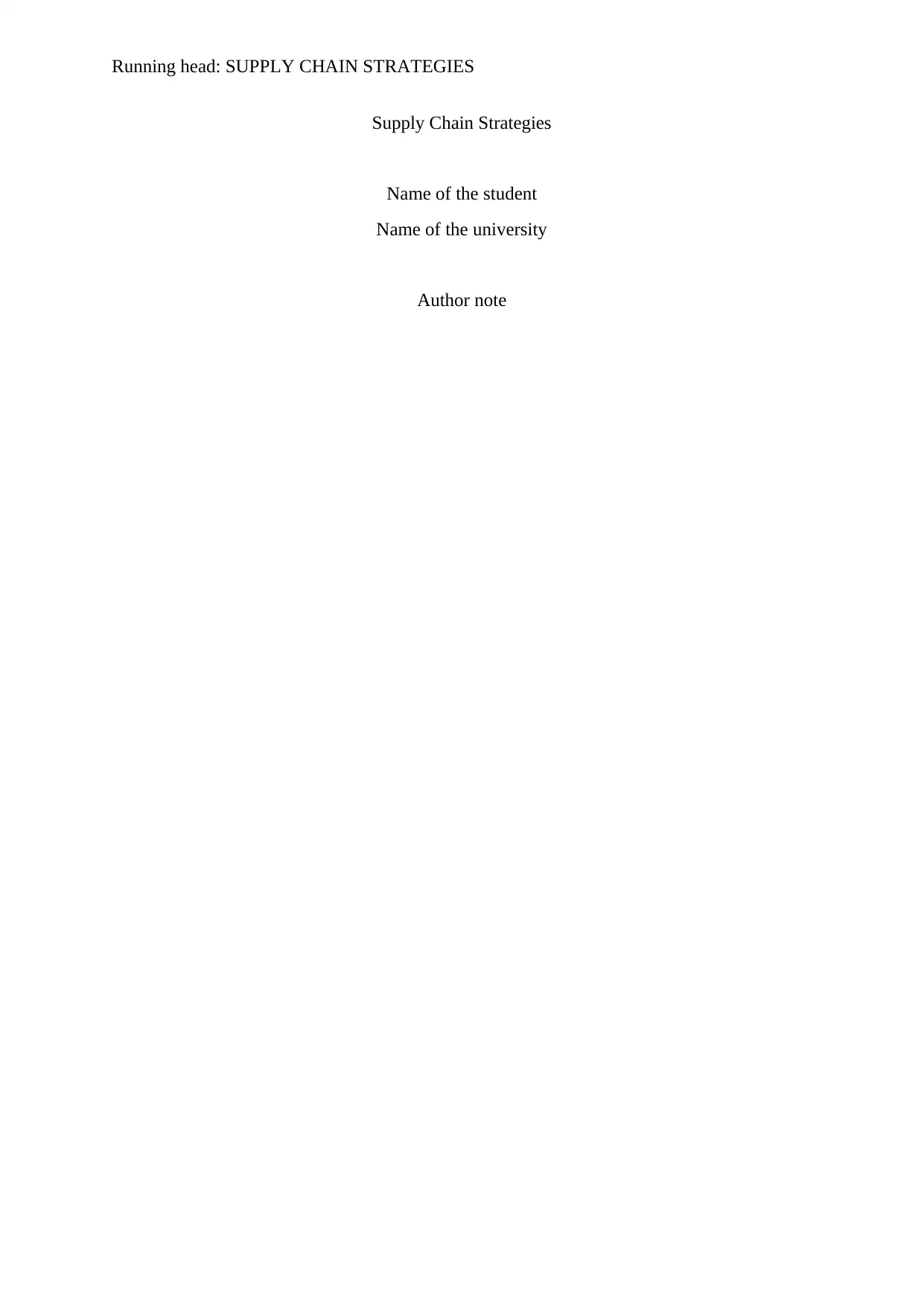
Running head: SUPPLY CHAIN STRATEGIES
Supply Chain Strategies
Name of the student
Name of the university
Author note
Supply Chain Strategies
Name of the student
Name of the university
Author note
Paraphrase This Document
Need a fresh take? Get an instant paraphrase of this document with our AI Paraphraser
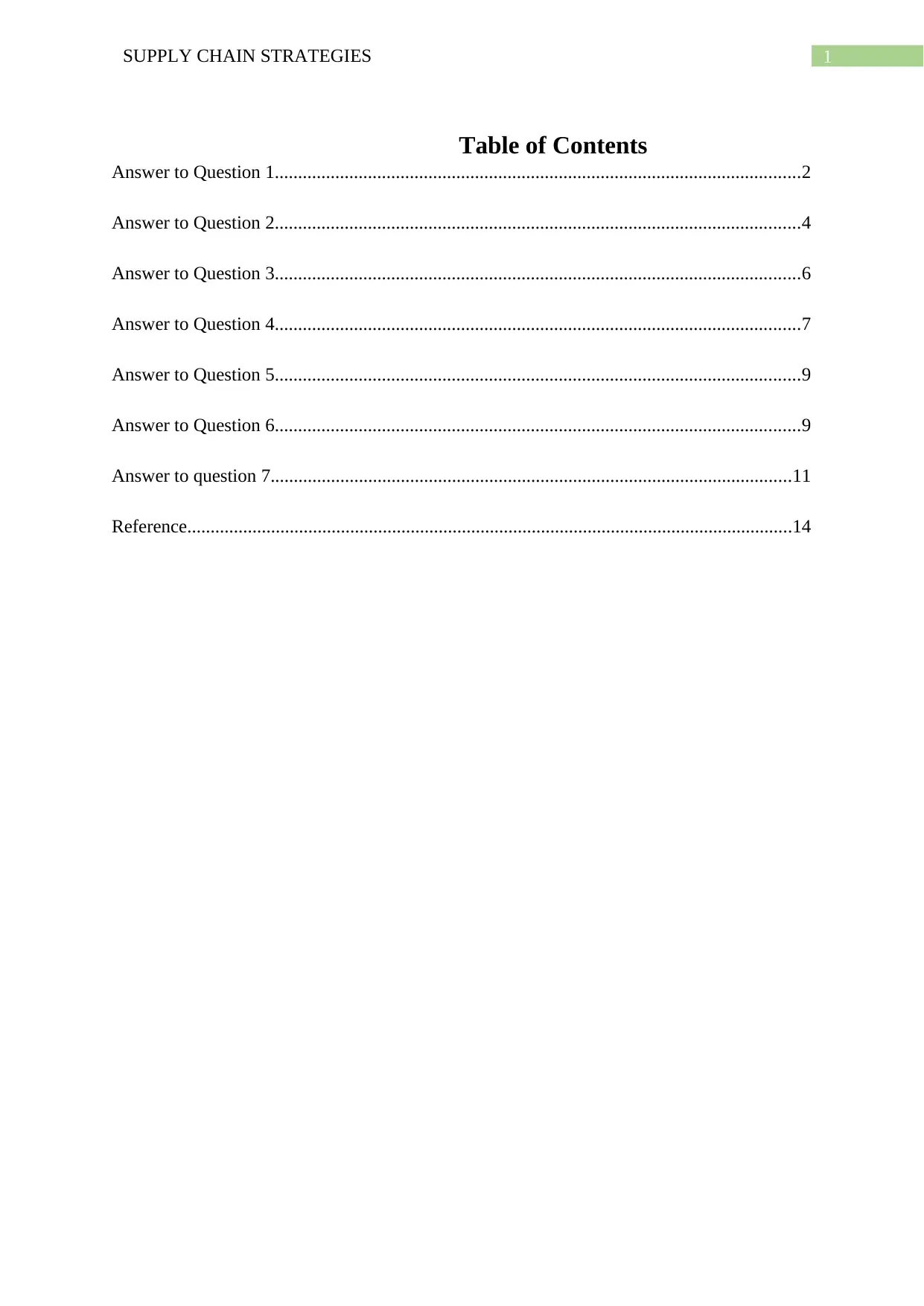
1SUPPLY CHAIN STRATEGIES
Table of Contents
Answer to Question 1.................................................................................................................2
Answer to Question 2.................................................................................................................4
Answer to Question 3.................................................................................................................6
Answer to Question 4.................................................................................................................7
Answer to Question 5.................................................................................................................9
Answer to Question 6.................................................................................................................9
Answer to question 7................................................................................................................11
Reference..................................................................................................................................14
Table of Contents
Answer to Question 1.................................................................................................................2
Answer to Question 2.................................................................................................................4
Answer to Question 3.................................................................................................................6
Answer to Question 4.................................................................................................................7
Answer to Question 5.................................................................................................................9
Answer to Question 6.................................................................................................................9
Answer to question 7................................................................................................................11
Reference..................................................................................................................................14
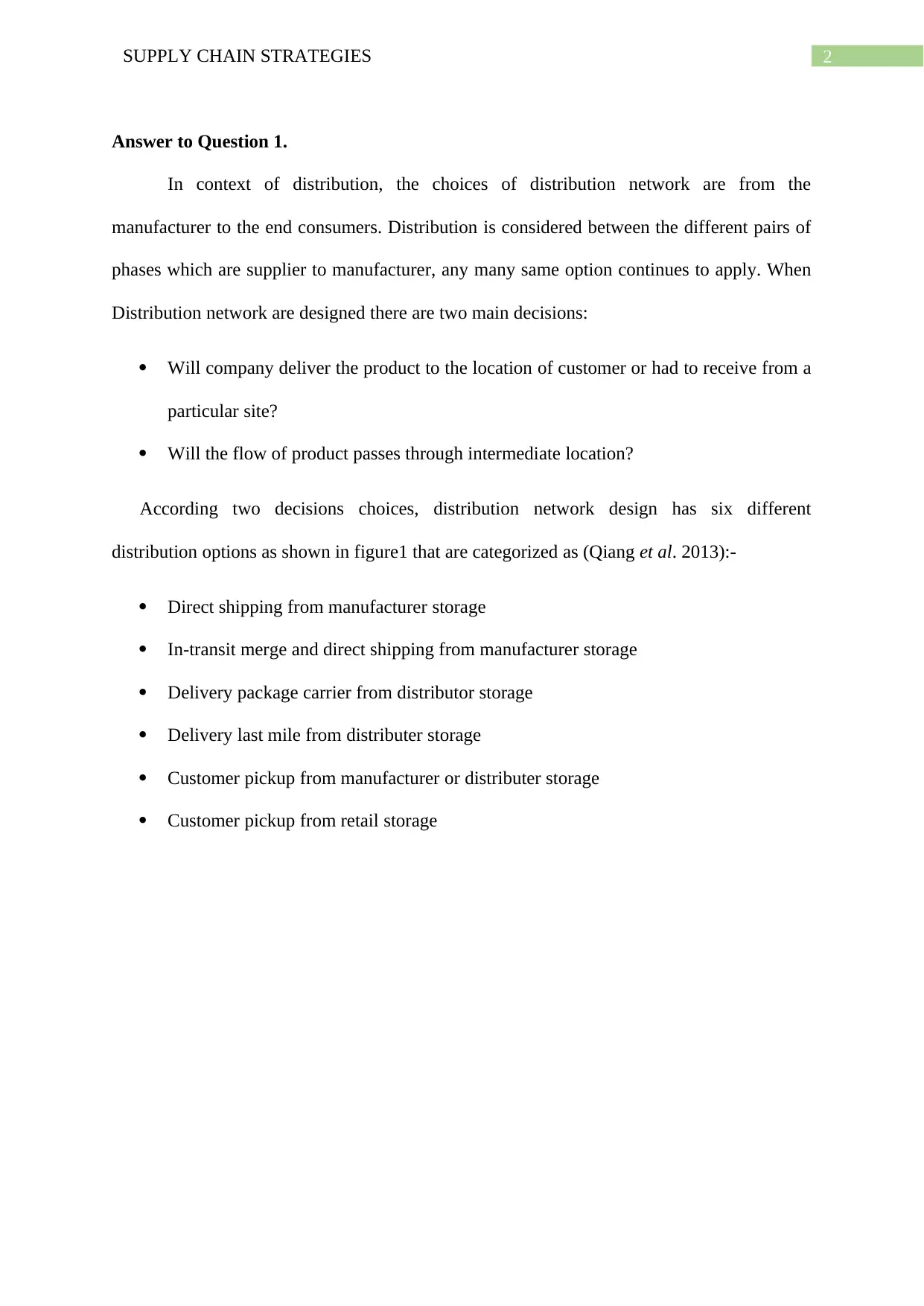
2SUPPLY CHAIN STRATEGIES
Answer to Question 1.
In context of distribution, the choices of distribution network are from the
manufacturer to the end consumers. Distribution is considered between the different pairs of
phases which are supplier to manufacturer, any many same option continues to apply. When
Distribution network are designed there are two main decisions:
Will company deliver the product to the location of customer or had to receive from a
particular site?
Will the flow of product passes through intermediate location?
According two decisions choices, distribution network design has six different
distribution options as shown in figure1 that are categorized as (Qiang et al. 2013):-
Direct shipping from manufacturer storage
In-transit merge and direct shipping from manufacturer storage
Delivery package carrier from distributor storage
Delivery last mile from distributer storage
Customer pickup from manufacturer or distributer storage
Customer pickup from retail storage
Answer to Question 1.
In context of distribution, the choices of distribution network are from the
manufacturer to the end consumers. Distribution is considered between the different pairs of
phases which are supplier to manufacturer, any many same option continues to apply. When
Distribution network are designed there are two main decisions:
Will company deliver the product to the location of customer or had to receive from a
particular site?
Will the flow of product passes through intermediate location?
According two decisions choices, distribution network design has six different
distribution options as shown in figure1 that are categorized as (Qiang et al. 2013):-
Direct shipping from manufacturer storage
In-transit merge and direct shipping from manufacturer storage
Delivery package carrier from distributor storage
Delivery last mile from distributer storage
Customer pickup from manufacturer or distributer storage
Customer pickup from retail storage
⊘ This is a preview!⊘
Do you want full access?
Subscribe today to unlock all pages.

Trusted by 1+ million students worldwide
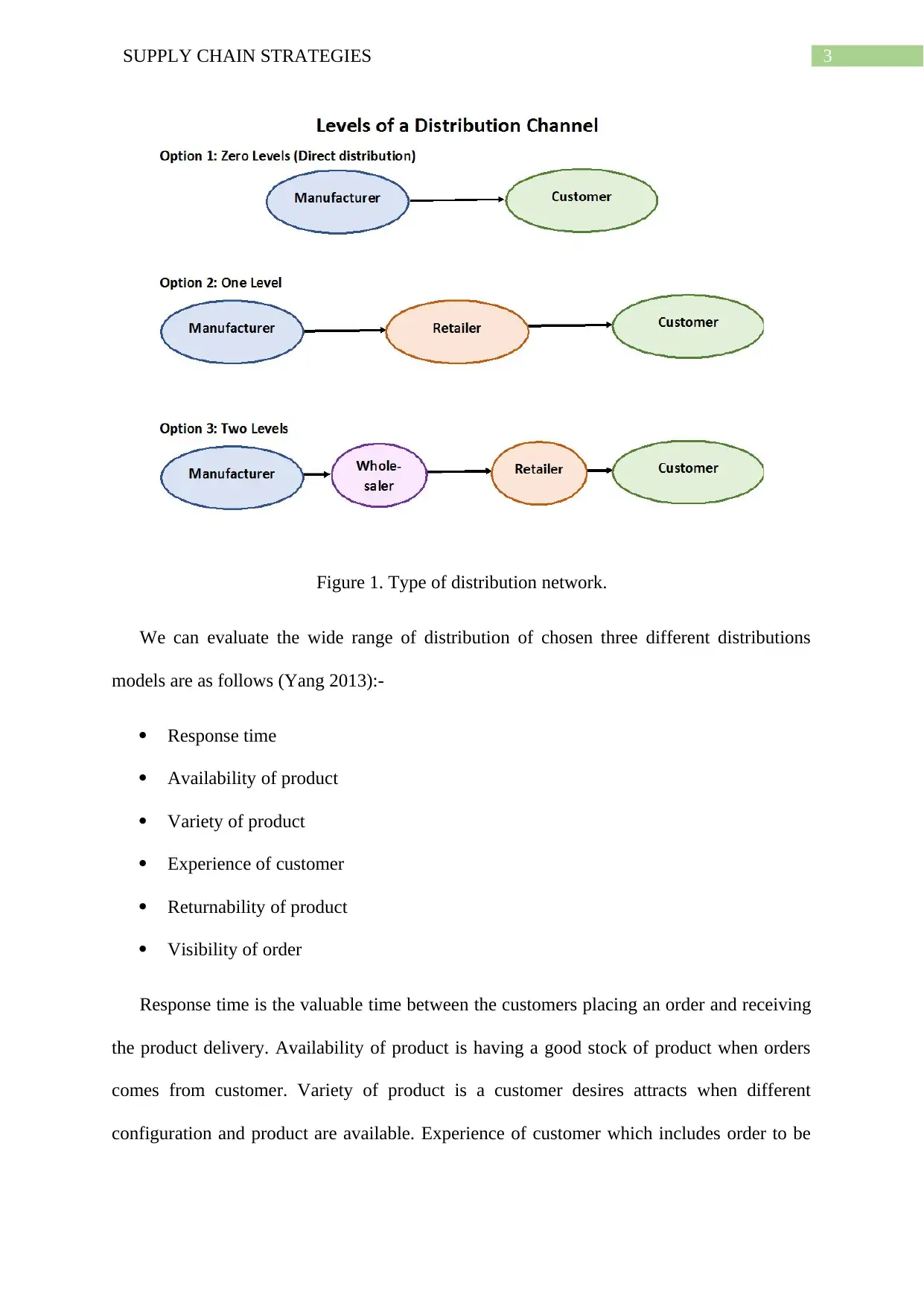
3SUPPLY CHAIN STRATEGIES
Figure 1. Type of distribution network.
We can evaluate the wide range of distribution of chosen three different distributions
models are as follows (Yang 2013):-
Response time
Availability of product
Variety of product
Experience of customer
Returnability of product
Visibility of order
Response time is the valuable time between the customers placing an order and receiving
the product delivery. Availability of product is having a good stock of product when orders
comes from customer. Variety of product is a customer desires attracts when different
configuration and product are available. Experience of customer which includes order to be
Figure 1. Type of distribution network.
We can evaluate the wide range of distribution of chosen three different distributions
models are as follows (Yang 2013):-
Response time
Availability of product
Variety of product
Experience of customer
Returnability of product
Visibility of order
Response time is the valuable time between the customers placing an order and receiving
the product delivery. Availability of product is having a good stock of product when orders
comes from customer. Variety of product is a customer desires attracts when different
configuration and product are available. Experience of customer which includes order to be
Paraphrase This Document
Need a fresh take? Get an instant paraphrase of this document with our AI Paraphraser
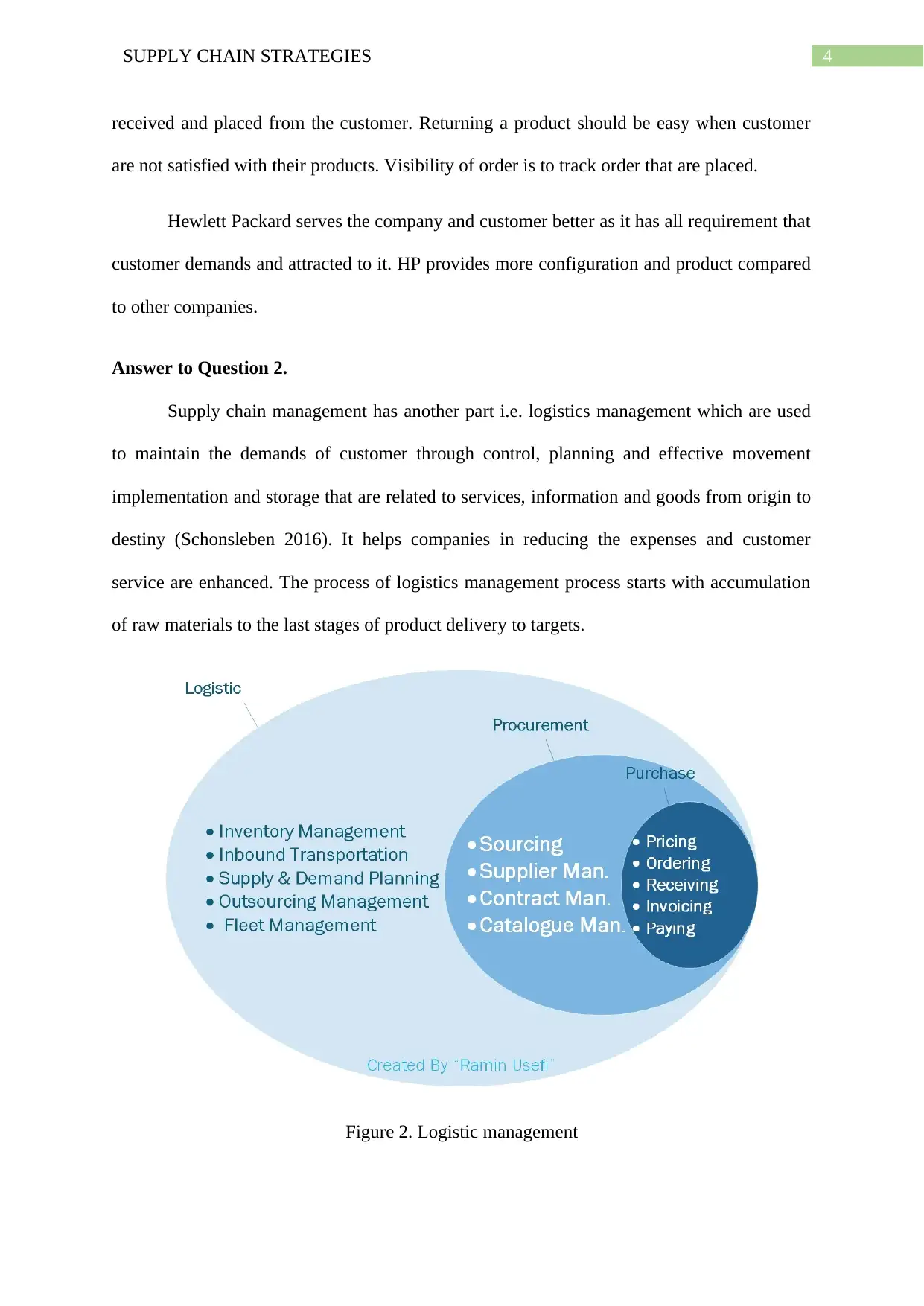
4SUPPLY CHAIN STRATEGIES
received and placed from the customer. Returning a product should be easy when customer
are not satisfied with their products. Visibility of order is to track order that are placed.
Hewlett Packard serves the company and customer better as it has all requirement that
customer demands and attracted to it. HP provides more configuration and product compared
to other companies.
Answer to Question 2.
Supply chain management has another part i.e. logistics management which are used
to maintain the demands of customer through control, planning and effective movement
implementation and storage that are related to services, information and goods from origin to
destiny (Schonsleben 2016). It helps companies in reducing the expenses and customer
service are enhanced. The process of logistics management process starts with accumulation
of raw materials to the last stages of product delivery to targets.
Figure 2. Logistic management
received and placed from the customer. Returning a product should be easy when customer
are not satisfied with their products. Visibility of order is to track order that are placed.
Hewlett Packard serves the company and customer better as it has all requirement that
customer demands and attracted to it. HP provides more configuration and product compared
to other companies.
Answer to Question 2.
Supply chain management has another part i.e. logistics management which are used
to maintain the demands of customer through control, planning and effective movement
implementation and storage that are related to services, information and goods from origin to
destiny (Schonsleben 2016). It helps companies in reducing the expenses and customer
service are enhanced. The process of logistics management process starts with accumulation
of raw materials to the last stages of product delivery to targets.
Figure 2. Logistic management
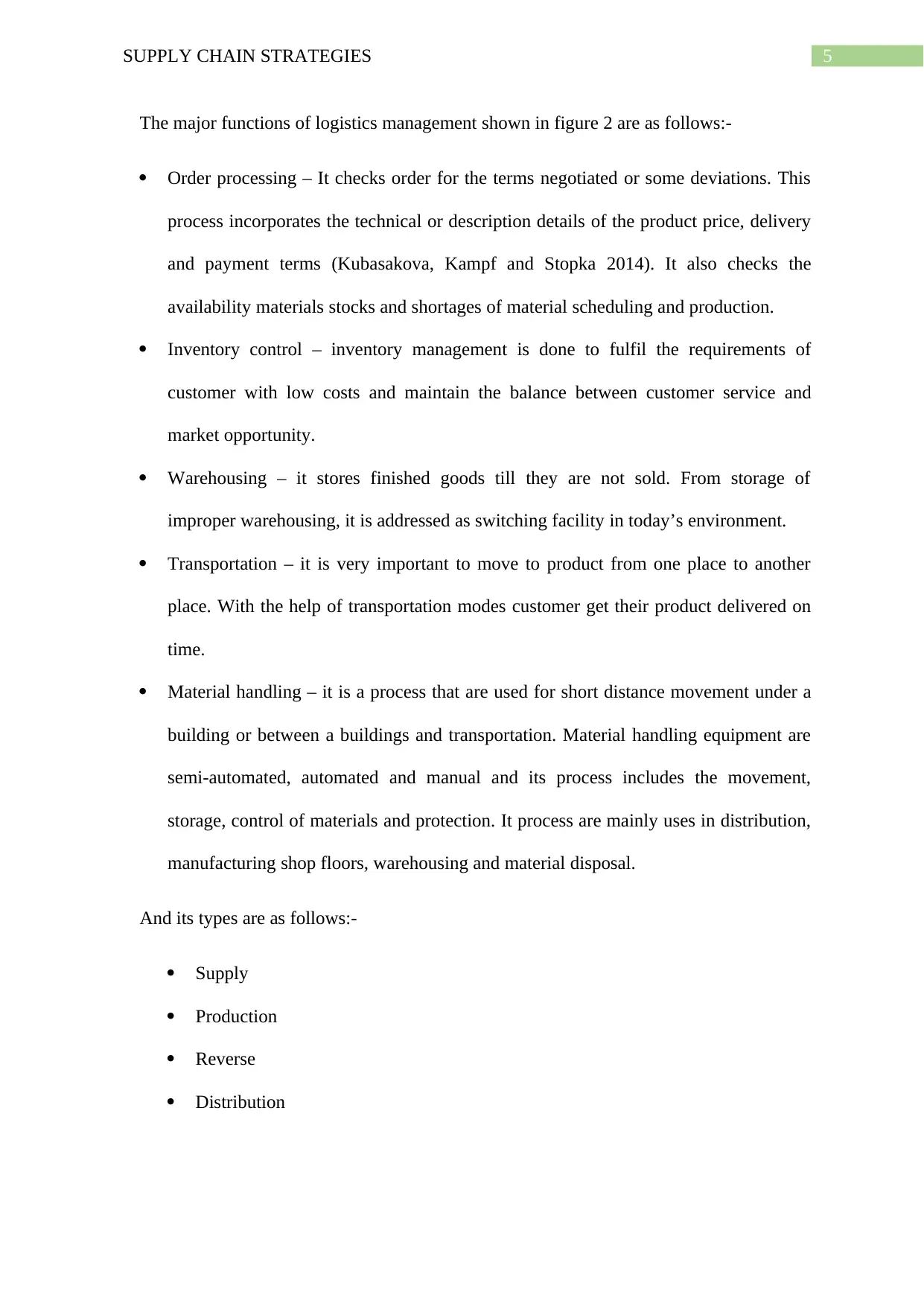
5SUPPLY CHAIN STRATEGIES
The major functions of logistics management shown in figure 2 are as follows:-
Order processing – It checks order for the terms negotiated or some deviations. This
process incorporates the technical or description details of the product price, delivery
and payment terms (Kubasakova, Kampf and Stopka 2014). It also checks the
availability materials stocks and shortages of material scheduling and production.
Inventory control – inventory management is done to fulfil the requirements of
customer with low costs and maintain the balance between customer service and
market opportunity.
Warehousing – it stores finished goods till they are not sold. From storage of
improper warehousing, it is addressed as switching facility in today’s environment.
Transportation – it is very important to move to product from one place to another
place. With the help of transportation modes customer get their product delivered on
time.
Material handling – it is a process that are used for short distance movement under a
building or between a buildings and transportation. Material handling equipment are
semi-automated, automated and manual and its process includes the movement,
storage, control of materials and protection. It process are mainly uses in distribution,
manufacturing shop floors, warehousing and material disposal.
And its types are as follows:-
Supply
Production
Reverse
Distribution
The major functions of logistics management shown in figure 2 are as follows:-
Order processing – It checks order for the terms negotiated or some deviations. This
process incorporates the technical or description details of the product price, delivery
and payment terms (Kubasakova, Kampf and Stopka 2014). It also checks the
availability materials stocks and shortages of material scheduling and production.
Inventory control – inventory management is done to fulfil the requirements of
customer with low costs and maintain the balance between customer service and
market opportunity.
Warehousing – it stores finished goods till they are not sold. From storage of
improper warehousing, it is addressed as switching facility in today’s environment.
Transportation – it is very important to move to product from one place to another
place. With the help of transportation modes customer get their product delivered on
time.
Material handling – it is a process that are used for short distance movement under a
building or between a buildings and transportation. Material handling equipment are
semi-automated, automated and manual and its process includes the movement,
storage, control of materials and protection. It process are mainly uses in distribution,
manufacturing shop floors, warehousing and material disposal.
And its types are as follows:-
Supply
Production
Reverse
Distribution
⊘ This is a preview!⊘
Do you want full access?
Subscribe today to unlock all pages.

Trusted by 1+ million students worldwide
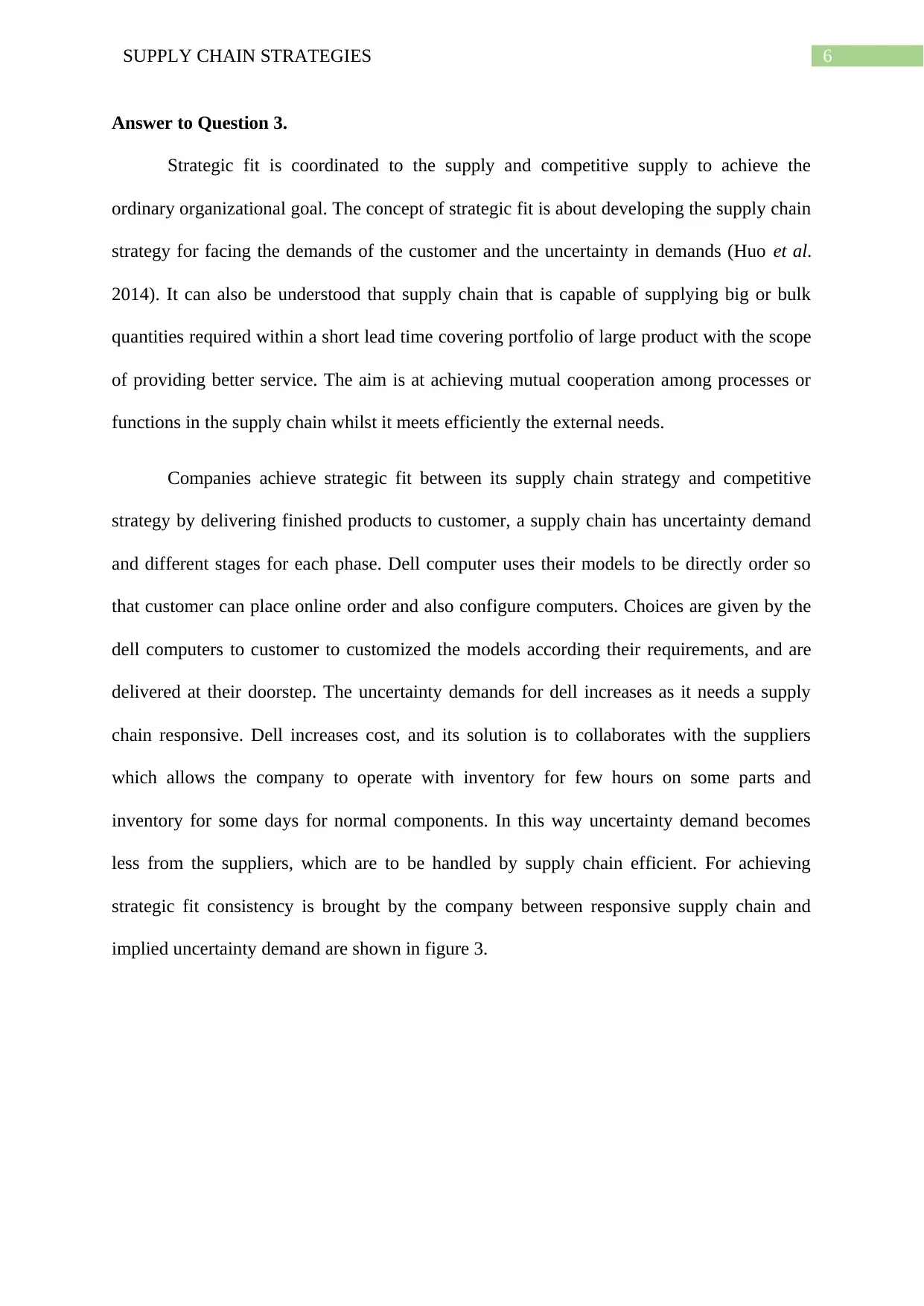
6SUPPLY CHAIN STRATEGIES
Answer to Question 3.
Strategic fit is coordinated to the supply and competitive supply to achieve the
ordinary organizational goal. The concept of strategic fit is about developing the supply chain
strategy for facing the demands of the customer and the uncertainty in demands (Huo et al.
2014). It can also be understood that supply chain that is capable of supplying big or bulk
quantities required within a short lead time covering portfolio of large product with the scope
of providing better service. The aim is at achieving mutual cooperation among processes or
functions in the supply chain whilst it meets efficiently the external needs.
Companies achieve strategic fit between its supply chain strategy and competitive
strategy by delivering finished products to customer, a supply chain has uncertainty demand
and different stages for each phase. Dell computer uses their models to be directly order so
that customer can place online order and also configure computers. Choices are given by the
dell computers to customer to customized the models according their requirements, and are
delivered at their doorstep. The uncertainty demands for dell increases as it needs a supply
chain responsive. Dell increases cost, and its solution is to collaborates with the suppliers
which allows the company to operate with inventory for few hours on some parts and
inventory for some days for normal components. In this way uncertainty demand becomes
less from the suppliers, which are to be handled by supply chain efficient. For achieving
strategic fit consistency is brought by the company between responsive supply chain and
implied uncertainty demand are shown in figure 3.
Answer to Question 3.
Strategic fit is coordinated to the supply and competitive supply to achieve the
ordinary organizational goal. The concept of strategic fit is about developing the supply chain
strategy for facing the demands of the customer and the uncertainty in demands (Huo et al.
2014). It can also be understood that supply chain that is capable of supplying big or bulk
quantities required within a short lead time covering portfolio of large product with the scope
of providing better service. The aim is at achieving mutual cooperation among processes or
functions in the supply chain whilst it meets efficiently the external needs.
Companies achieve strategic fit between its supply chain strategy and competitive
strategy by delivering finished products to customer, a supply chain has uncertainty demand
and different stages for each phase. Dell computer uses their models to be directly order so
that customer can place online order and also configure computers. Choices are given by the
dell computers to customer to customized the models according their requirements, and are
delivered at their doorstep. The uncertainty demands for dell increases as it needs a supply
chain responsive. Dell increases cost, and its solution is to collaborates with the suppliers
which allows the company to operate with inventory for few hours on some parts and
inventory for some days for normal components. In this way uncertainty demand becomes
less from the suppliers, which are to be handled by supply chain efficient. For achieving
strategic fit consistency is brought by the company between responsive supply chain and
implied uncertainty demand are shown in figure 3.
Paraphrase This Document
Need a fresh take? Get an instant paraphrase of this document with our AI Paraphraser
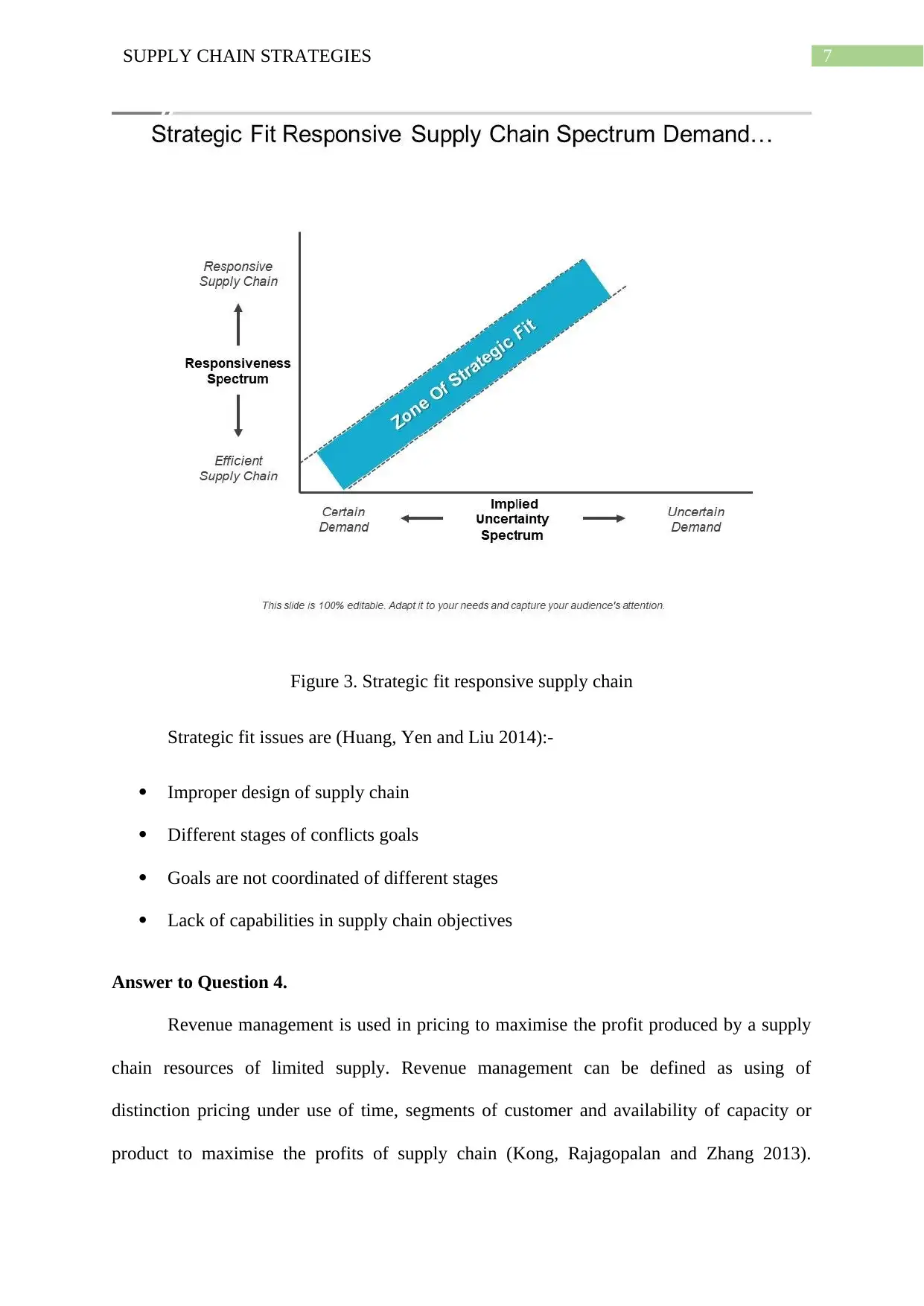
7SUPPLY CHAIN STRATEGIES
Figure 3. Strategic fit responsive supply chain
Strategic fit issues are (Huang, Yen and Liu 2014):-
Improper design of supply chain
Different stages of conflicts goals
Goals are not coordinated of different stages
Lack of capabilities in supply chain objectives
Answer to Question 4.
Revenue management is used in pricing to maximise the profit produced by a supply
chain resources of limited supply. Revenue management can be defined as using of
distinction pricing under use of time, segments of customer and availability of capacity or
product to maximise the profits of supply chain (Kong, Rajagopalan and Zhang 2013).
Figure 3. Strategic fit responsive supply chain
Strategic fit issues are (Huang, Yen and Liu 2014):-
Improper design of supply chain
Different stages of conflicts goals
Goals are not coordinated of different stages
Lack of capabilities in supply chain objectives
Answer to Question 4.
Revenue management is used in pricing to maximise the profit produced by a supply
chain resources of limited supply. Revenue management can be defined as using of
distinction pricing under use of time, segments of customer and availability of capacity or
product to maximise the profits of supply chain (Kong, Rajagopalan and Zhang 2013).
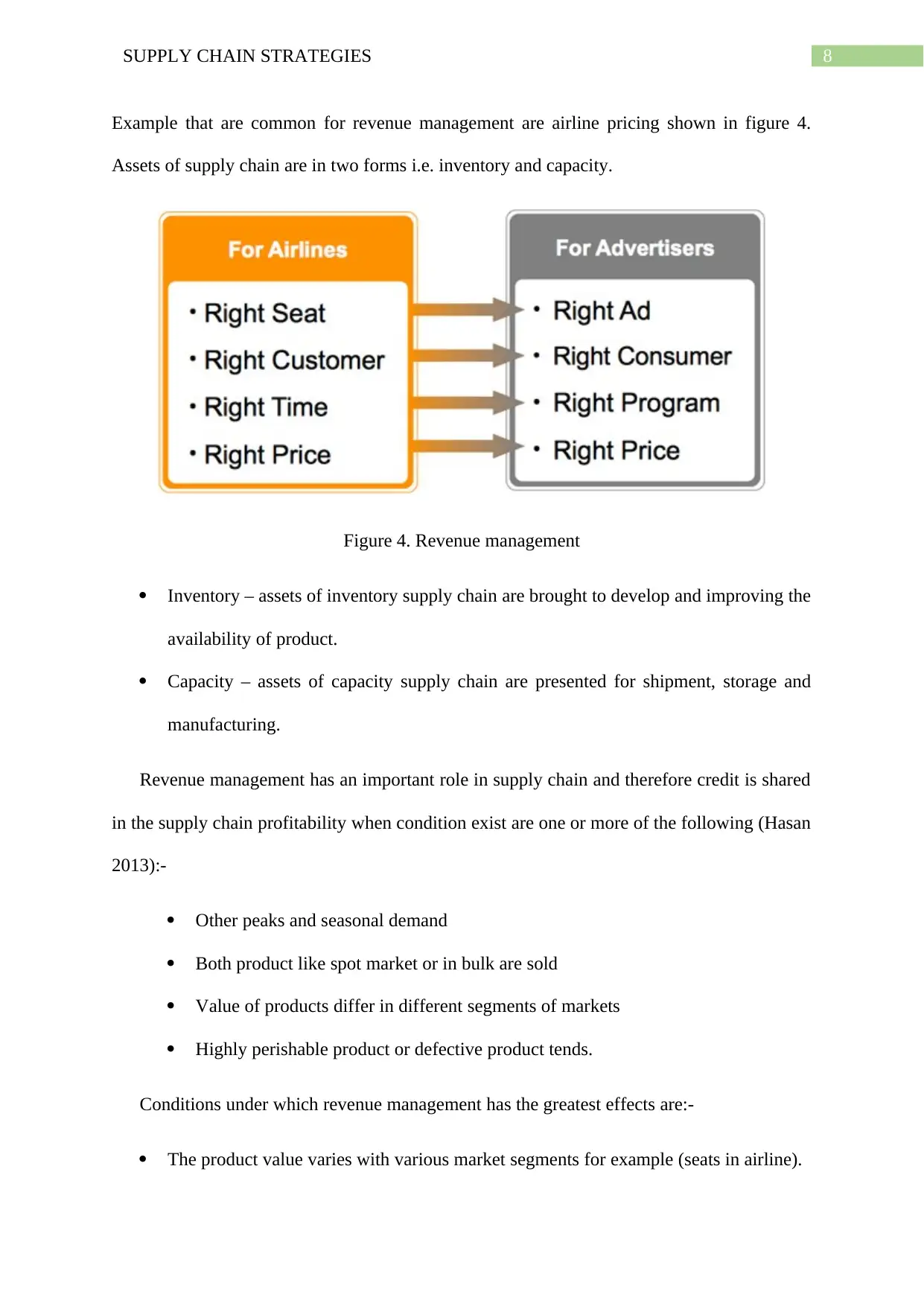
8SUPPLY CHAIN STRATEGIES
Example that are common for revenue management are airline pricing shown in figure 4.
Assets of supply chain are in two forms i.e. inventory and capacity.
Figure 4. Revenue management
Inventory – assets of inventory supply chain are brought to develop and improving the
availability of product.
Capacity – assets of capacity supply chain are presented for shipment, storage and
manufacturing.
Revenue management has an important role in supply chain and therefore credit is shared
in the supply chain profitability when condition exist are one or more of the following (Hasan
2013):-
Other peaks and seasonal demand
Both product like spot market or in bulk are sold
Value of products differ in different segments of markets
Highly perishable product or defective product tends.
Conditions under which revenue management has the greatest effects are:-
The product value varies with various market segments for example (seats in airline).
Example that are common for revenue management are airline pricing shown in figure 4.
Assets of supply chain are in two forms i.e. inventory and capacity.
Figure 4. Revenue management
Inventory – assets of inventory supply chain are brought to develop and improving the
availability of product.
Capacity – assets of capacity supply chain are presented for shipment, storage and
manufacturing.
Revenue management has an important role in supply chain and therefore credit is shared
in the supply chain profitability when condition exist are one or more of the following (Hasan
2013):-
Other peaks and seasonal demand
Both product like spot market or in bulk are sold
Value of products differ in different segments of markets
Highly perishable product or defective product tends.
Conditions under which revenue management has the greatest effects are:-
The product value varies with various market segments for example (seats in airline).
⊘ This is a preview!⊘
Do you want full access?
Subscribe today to unlock all pages.

Trusted by 1+ million students worldwide
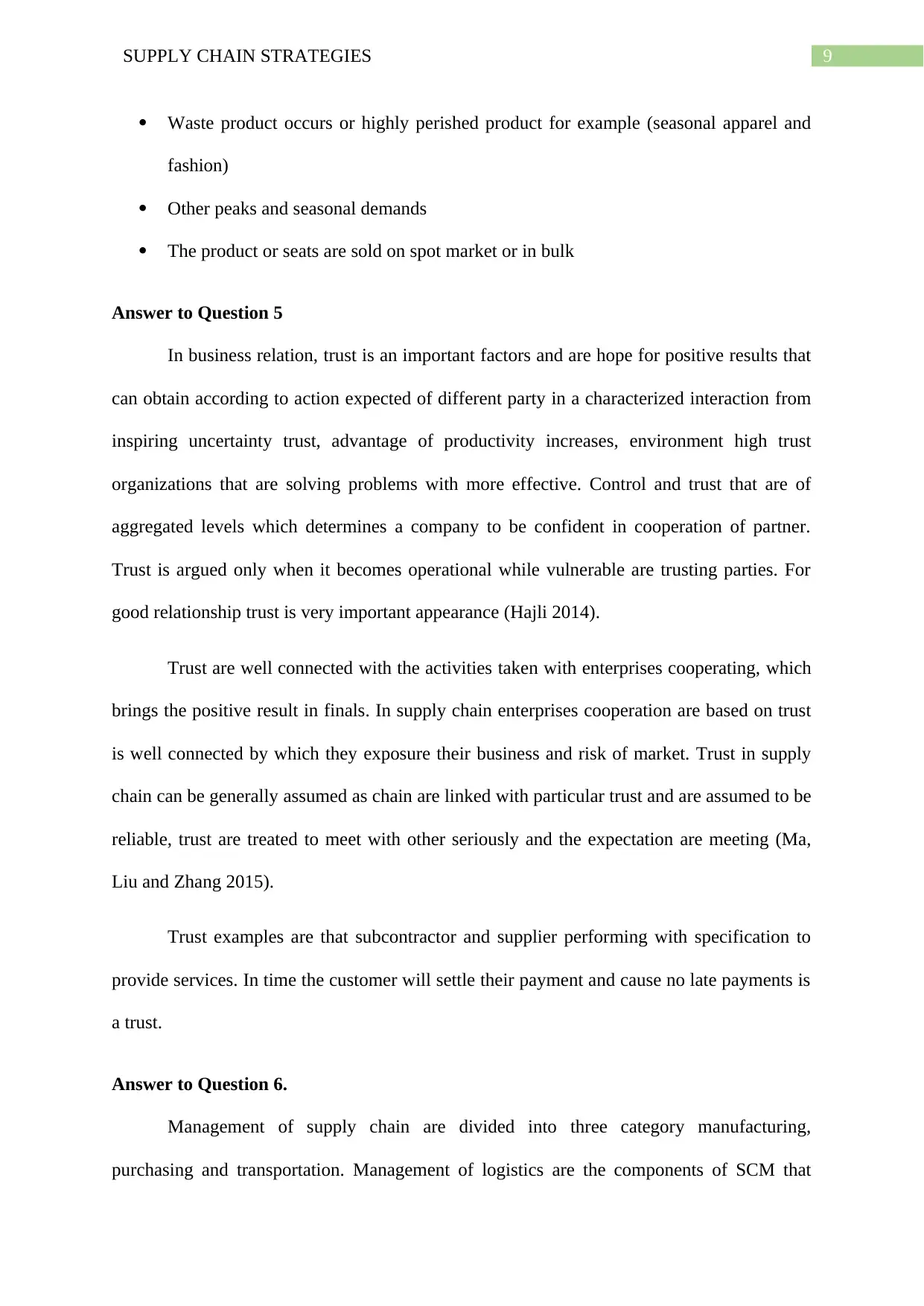
9SUPPLY CHAIN STRATEGIES
Waste product occurs or highly perished product for example (seasonal apparel and
fashion)
Other peaks and seasonal demands
The product or seats are sold on spot market or in bulk
Answer to Question 5
In business relation, trust is an important factors and are hope for positive results that
can obtain according to action expected of different party in a characterized interaction from
inspiring uncertainty trust, advantage of productivity increases, environment high trust
organizations that are solving problems with more effective. Control and trust that are of
aggregated levels which determines a company to be confident in cooperation of partner.
Trust is argued only when it becomes operational while vulnerable are trusting parties. For
good relationship trust is very important appearance (Hajli 2014).
Trust are well connected with the activities taken with enterprises cooperating, which
brings the positive result in finals. In supply chain enterprises cooperation are based on trust
is well connected by which they exposure their business and risk of market. Trust in supply
chain can be generally assumed as chain are linked with particular trust and are assumed to be
reliable, trust are treated to meet with other seriously and the expectation are meeting (Ma,
Liu and Zhang 2015).
Trust examples are that subcontractor and supplier performing with specification to
provide services. In time the customer will settle their payment and cause no late payments is
a trust.
Answer to Question 6.
Management of supply chain are divided into three category manufacturing,
purchasing and transportation. Management of logistics are the components of SCM that
Waste product occurs or highly perished product for example (seasonal apparel and
fashion)
Other peaks and seasonal demands
The product or seats are sold on spot market or in bulk
Answer to Question 5
In business relation, trust is an important factors and are hope for positive results that
can obtain according to action expected of different party in a characterized interaction from
inspiring uncertainty trust, advantage of productivity increases, environment high trust
organizations that are solving problems with more effective. Control and trust that are of
aggregated levels which determines a company to be confident in cooperation of partner.
Trust is argued only when it becomes operational while vulnerable are trusting parties. For
good relationship trust is very important appearance (Hajli 2014).
Trust are well connected with the activities taken with enterprises cooperating, which
brings the positive result in finals. In supply chain enterprises cooperation are based on trust
is well connected by which they exposure their business and risk of market. Trust in supply
chain can be generally assumed as chain are linked with particular trust and are assumed to be
reliable, trust are treated to meet with other seriously and the expectation are meeting (Ma,
Liu and Zhang 2015).
Trust examples are that subcontractor and supplier performing with specification to
provide services. In time the customer will settle their payment and cause no late payments is
a trust.
Answer to Question 6.
Management of supply chain are divided into three category manufacturing,
purchasing and transportation. Management of logistics are the components of SCM that
Paraphrase This Document
Need a fresh take? Get an instant paraphrase of this document with our AI Paraphraser
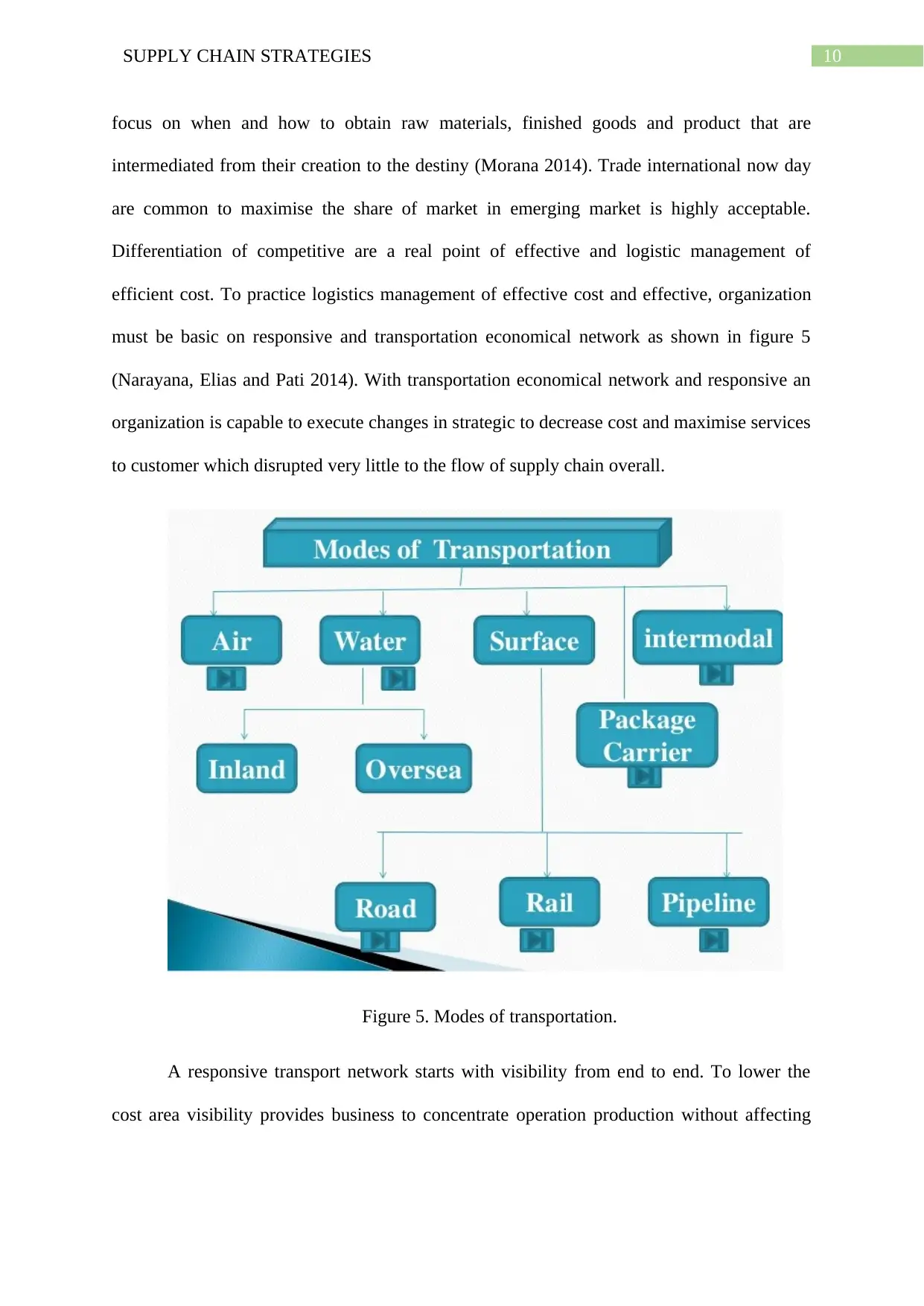
10SUPPLY CHAIN STRATEGIES
focus on when and how to obtain raw materials, finished goods and product that are
intermediated from their creation to the destiny (Morana 2014). Trade international now day
are common to maximise the share of market in emerging market is highly acceptable.
Differentiation of competitive are a real point of effective and logistic management of
efficient cost. To practice logistics management of effective cost and effective, organization
must be basic on responsive and transportation economical network as shown in figure 5
(Narayana, Elias and Pati 2014). With transportation economical network and responsive an
organization is capable to execute changes in strategic to decrease cost and maximise services
to customer which disrupted very little to the flow of supply chain overall.
Figure 5. Modes of transportation.
A responsive transport network starts with visibility from end to end. To lower the
cost area visibility provides business to concentrate operation production without affecting
focus on when and how to obtain raw materials, finished goods and product that are
intermediated from their creation to the destiny (Morana 2014). Trade international now day
are common to maximise the share of market in emerging market is highly acceptable.
Differentiation of competitive are a real point of effective and logistic management of
efficient cost. To practice logistics management of effective cost and effective, organization
must be basic on responsive and transportation economical network as shown in figure 5
(Narayana, Elias and Pati 2014). With transportation economical network and responsive an
organization is capable to execute changes in strategic to decrease cost and maximise services
to customer which disrupted very little to the flow of supply chain overall.
Figure 5. Modes of transportation.
A responsive transport network starts with visibility from end to end. To lower the
cost area visibility provides business to concentrate operation production without affecting
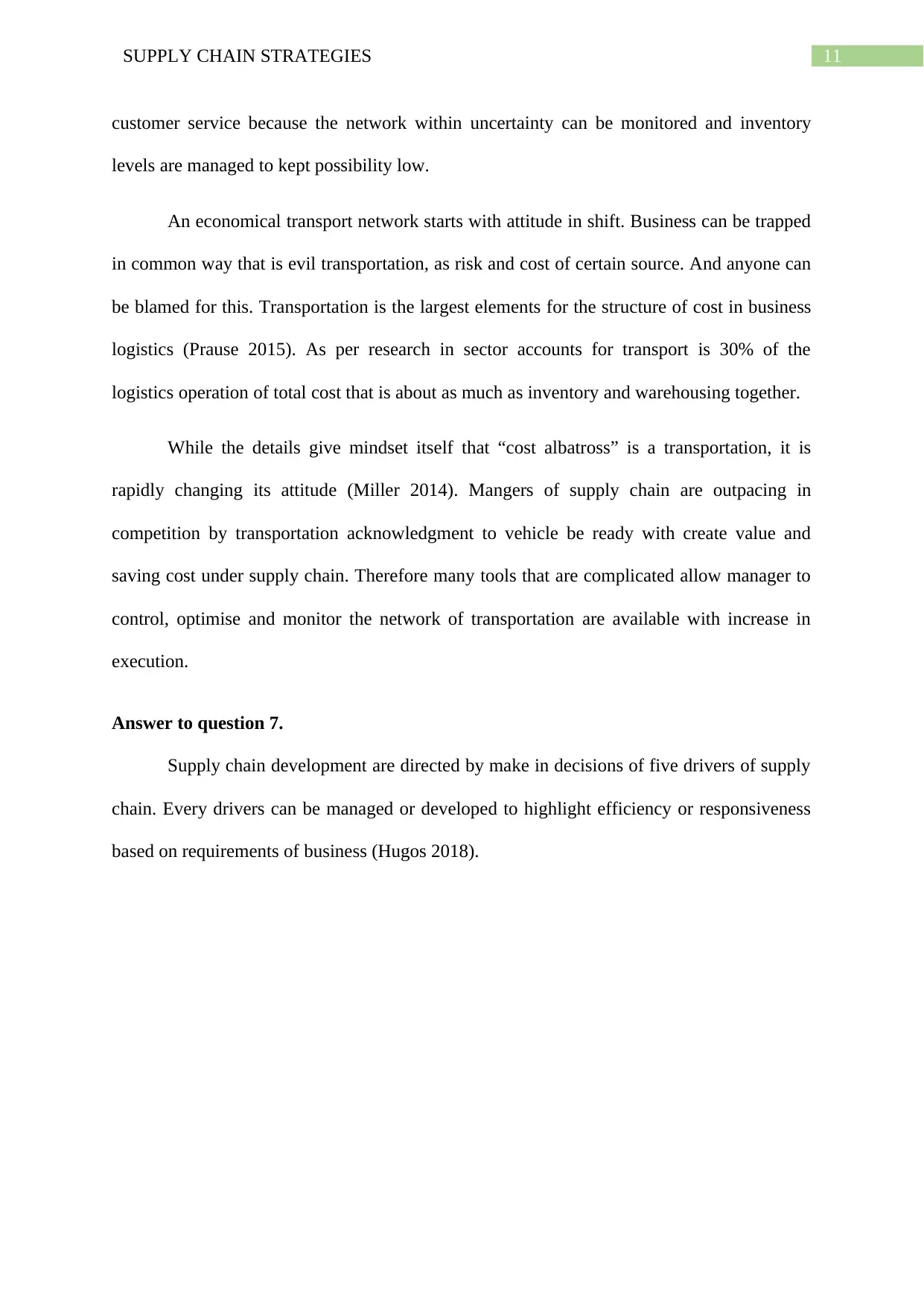
11SUPPLY CHAIN STRATEGIES
customer service because the network within uncertainty can be monitored and inventory
levels are managed to kept possibility low.
An economical transport network starts with attitude in shift. Business can be trapped
in common way that is evil transportation, as risk and cost of certain source. And anyone can
be blamed for this. Transportation is the largest elements for the structure of cost in business
logistics (Prause 2015). As per research in sector accounts for transport is 30% of the
logistics operation of total cost that is about as much as inventory and warehousing together.
While the details give mindset itself that “cost albatross” is a transportation, it is
rapidly changing its attitude (Miller 2014). Mangers of supply chain are outpacing in
competition by transportation acknowledgment to vehicle be ready with create value and
saving cost under supply chain. Therefore many tools that are complicated allow manager to
control, optimise and monitor the network of transportation are available with increase in
execution.
Answer to question 7.
Supply chain development are directed by make in decisions of five drivers of supply
chain. Every drivers can be managed or developed to highlight efficiency or responsiveness
based on requirements of business (Hugos 2018).
customer service because the network within uncertainty can be monitored and inventory
levels are managed to kept possibility low.
An economical transport network starts with attitude in shift. Business can be trapped
in common way that is evil transportation, as risk and cost of certain source. And anyone can
be blamed for this. Transportation is the largest elements for the structure of cost in business
logistics (Prause 2015). As per research in sector accounts for transport is 30% of the
logistics operation of total cost that is about as much as inventory and warehousing together.
While the details give mindset itself that “cost albatross” is a transportation, it is
rapidly changing its attitude (Miller 2014). Mangers of supply chain are outpacing in
competition by transportation acknowledgment to vehicle be ready with create value and
saving cost under supply chain. Therefore many tools that are complicated allow manager to
control, optimise and monitor the network of transportation are available with increase in
execution.
Answer to question 7.
Supply chain development are directed by make in decisions of five drivers of supply
chain. Every drivers can be managed or developed to highlight efficiency or responsiveness
based on requirements of business (Hugos 2018).
⊘ This is a preview!⊘
Do you want full access?
Subscribe today to unlock all pages.

Trusted by 1+ million students worldwide
1 out of 17
Related Documents
Your All-in-One AI-Powered Toolkit for Academic Success.
+13062052269
info@desklib.com
Available 24*7 on WhatsApp / Email
![[object Object]](/_next/static/media/star-bottom.7253800d.svg)
Unlock your academic potential
Copyright © 2020–2025 A2Z Services. All Rights Reserved. Developed and managed by ZUCOL.



